Where do you start when choosing plants for balcony gardens? A garden is always a reflection of a gardener, and balcony gardens are one of the most unique spaces you choose to grow.
Their challenges range from added wind, to salt exposure, over-heating, and city fumes, so choosing plants for the balcony that can not only cope in tough conditions, but thrive, is essential.
Our guide to balcony plants covers some of the most reliable and productive vegetables you can grow, and plants for specific conditions, but for more information on balcony gardening, read our ultimate guide to the balcony garden, where we’ve added more detail about exactly what tools you need to keep your balcony plants at their happiest.
More...
What to Consider When Choosing Plants for Balcony Gardens
There is no single guide that covers all balcony gardens, so we’ve chunked things down to four main sections: North facing balcony gardens, South facing balcony gardens, Small balcony gardens, and Apartment balcony gardens.

North Facing Balcony Gardens
If you’ve got a North facing balcony, especially on a modern apartment block, there is no reason to limit your vision at all. Think green walls, think water, think trees. Small spaces don’t need to mean small plants.
Australian gardens have water at their heart. Whether it’s a pool or a pond, so if you want a garden that works like everything you’re used to, including water is essential, and most modern balconies can accommodate the added weight.
I’m not talking about a jacuzzi, but a small solar powered water feature, or a pond planted up with oxygenating lilies to dip your feet in on a warm summer evening could be the difference between a used garden, and a forgotten one.
As for planting, surround yourself and give your garden shade. It’ll help reduce your air conditioning use too if you can filter the light coming in, as well as filtering any dirty air from city traffic. We’ve got a great list of air purifying balcony plants later in this article.
South Facing Balcony Gardens
I mentioned earlier how useful small spaces can be. That’s because you can create spaces on a budget that will give you a feeling of complete escape, or forest retreats. Ferns, mosses, woodland planting. South facing, shaded balcony gardens can bring nature into your apartment.
Apartment Balcony Gardens
Gardening in an apartment block might seem daunting, largely because most apartments are floating dozens of metres over the ground.
That brings some added challenges to apartment gardens in the form of high winds, and cooler air. And if you’re nearer the coast, that cool air can be salty too.
But the restrictions of these balcony garden conditions can be really useful to you as a gardener too. Limitation isn’t necessarily bad. If you were cooking up dinner, you wouldn’t just throw the whole fridge at it, so why do that with your garden.
For most gardeners that means limiting your colour palette, but for balcony gardeners, that means finding a few great plants and nurturing them into something unique to you.
Read on for our guide to balcony plants, we’ve got some decent tips to get you started.


Get Your Free Guide:
Master Growing Australian Natives eBook
A Must Have Complete Guide for Every Australian Garden
Get Your Free Guide:
Master Growing Australian Natives eBook
A Must Have Complete Guide for Every Australian Garden
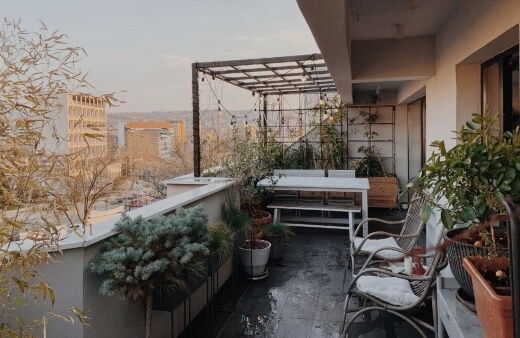
Small Balcony Gardens
I need to address the tiny elephant in the room; Juliet Balconies. Gardening in small balconies doesn't come much smaller than Juliet balconies, but that doesn’t mean we can’t still create incredible spaces to look at from inside and out.
A friend in Adelaide used to have a small 2nd floor Juliet balcony, absolutely packed with trailing ivy, bird feeders and hanging pots with ferns.
Barely any light came into his apartment, but the quality of the light that did was outstanding. It was, and remains, one of the most inspiring gardens I have ever known.
Best Plants for Balcony Gardening
Balcony Garden Vegetables and Fruits
Most balconies have a slightly higher than average temperature, especially when they are enclosed or walled in as heat from the apartment will be lost to the garden.
One great way to take advantage of that heat loss, is to plant the space up, and there is no better set of plants than vegetables for balcony gardens.
Vegetables that likes to trail or climb, or salad crops that can be harvested all year round are the perfect balcony plants; partly because you get to eat them, but also, any ground dwelling visitors will be blown away by your harvest, as you can often achieve much higher yields, particularly on sunny North facing balconies.
Tomatoes
One huge advantage of balcony gardening is that your garden is isolated from most pests and diseases, so you can easily grow heirloom tomato varieties without having to worry about blight.
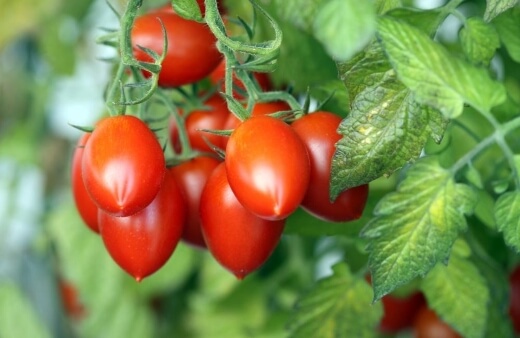
For most gardens on the ground, wind spread blight can lay wastes to crops, but a sunny Australian balcony is perfect for varieties like Roma or Grosse Lisse – two of the most versatile tomatoes you can buy, but also two or the most susceptible to blight.
Here are our top tips for growing juicy tomatoes in Australia.
Chillies
Planting chillies on a balcony has two major advantages. First, they look great and add a pop of summer and autumn colour to the balcony with their wide variety of colour.
Second, they adore the warmth of the apartment, and are really easy to propagate outdoors from seed as long as they have some decent wind protection for chilly weather (pun intended).
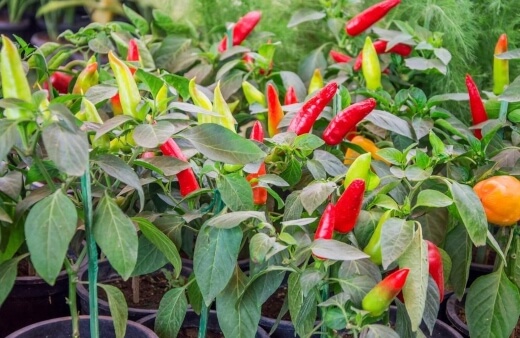
Try something like serrano, or loco, for a decent heat but with mountains of sweet undertones. Both grow brilliantly on balconies where you can control the soil, drainage and watering to perfection.
Locos are only small but the bushes' fruits change from green, to yellow, to orange, to red, to bright purple through the season, so there’s always something new to look at.
Cucumbers
Cucumbers and gherkins are the most striking climbing vegetables for a balcony, and they serve a great practical purpose too. (Learn more about growing cucumbers and the best varieties to grow in Australia here).
Like many of the climbing plants in the section below, they will shade the hottest sun, and block the harshest winds, so you can sit out on your balcony in the middle of summer with reliable shade.
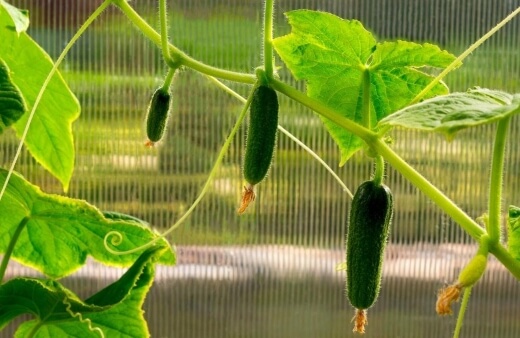
They are also really effective air purifiers, like many annual plants, as they grow tall and fast, using up maximum amounts of CO2 for photosynthesis in the process.
Telegraph varieties like English Hothouse produce sweeter cucumbers, making the most of the sugars produced during that air purifying process.
If you see leaves yellowing, check out this guide on why cucumber leaves are turning yellow.
Plants for Salad
I’m a big advocate of cut and come again crops for small spaces. So no iceberg lettuce, no radicchio. If you want to grow salad in a limited space, make sure it’s a plant that will work hard to get food on your plate for every meal.
Malabar Spinach grows as a vine, and in the warm north of Australia it will grow as a perennial, returning every year. As well as it’s distinctive hearty spinach taste, it is a highly ornamental climbing plant.
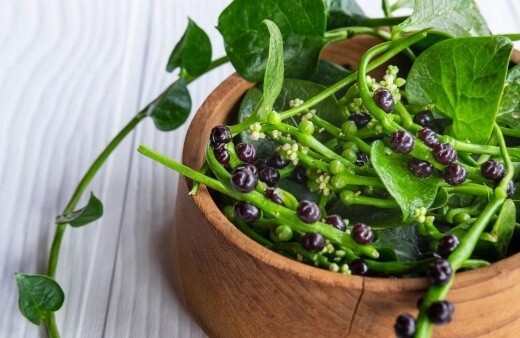
For Southern Australia, it can be cut back and stored indoors on a windowsill, where it should begin sprouting again in Spring. A well-watered Malabar Spinach in good compost will produce enough leaves for at least three meals per week through summer and early autumn.
For more compact growth try something like komatsuna, which can be used as a winter crop in warmer climates, and produces masses of leaves quickly. It can be sown over and over again through the year, and is usually ready to eat in as little as three weeks.
Carrots
Like Tomatoes, Carrots have some pretty persistent predators. In most of the USA and Europe carrot root flies are widespread, but they have been found in Australia recently, and are incredibly effective reproducers.
They do not fly higher than 1m from the ground though, so if you’re growing carrots on a balcony you will never ever have to worry.
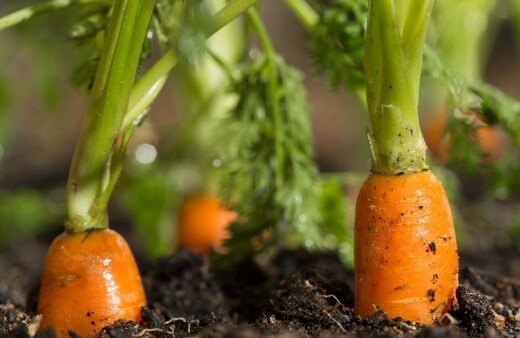
Grapes
Grapes will grow anywhere in Australia, but they love moisture. While they look great on a balcony making sure they have access to regular water is essential.
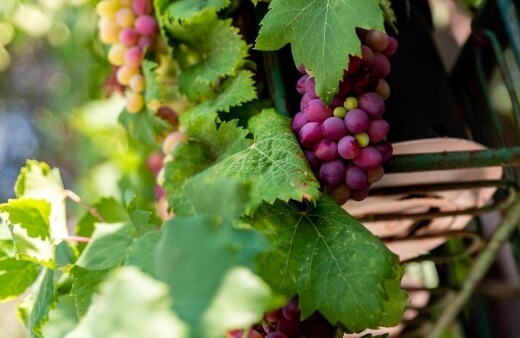
Most plants will be overloaded by a pot full of pure compost or rotted manure, but grapes love being fed, so planting them up a trellis in a planter full to the brim of moisture retentive compost will work wonders.
Related guide: How to prune grapevines in Australia.
Herbs
Soft leaved herbs like mint, basil, parsley and coriander can suffer in high winds and increased humidity, and while it’s very possible to grow them, the herbs that will give you great benefits are those with Mediterranean or alpine habits, like rosemary, sage, thyme and bay.

For herbs more suitable indoors, be sure to check our growing herbs indoors ultimate guide.
Air Purifying Balcony Plants
Black Bean Tree (Castanospermum australe)
Black Bean trees are perfect for an Australian balcony garden. They thrive in sunny conditions, and will eat up toxins in the air, using the carbon to feed their roots, and ultimately, their leaves.
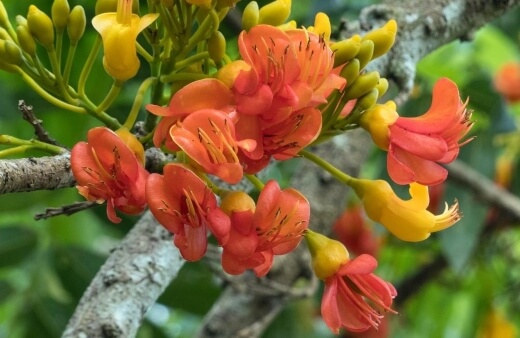
Their glossy forest green leaves add a depth to your garden all year round, with red or yellow pea flowers in summer. As long as you steer clear of the poisonous bean pods they produce, they make a perfect addition to any small balcony garden.
Rough Maidenhair Fern (Adiantum hispidulum)
Rough maidenhair ferns are incredible plants. They are one of the most popular air purifying plants all over the world, but thrive in any condition from full sun to full shade.
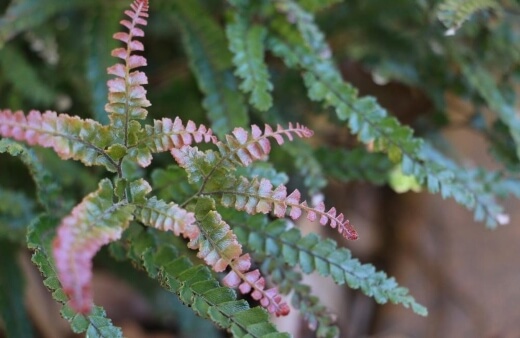
Their leaves have pink and russet tones that change through the year, and they work brilliantly as hanging basket plants, or draped from a vertical garden planter.
Here is a comprehensive guide on how to grow Maidenhair Ferns in Australia.
Native Orchids (Dendrobium kingianum)
Our native orchids will grow indoors and outdoors in Australia, but are usually sold as houseplants. Their tendency to be slightly picky with watering and soil can turn people off, but they are so worth the effort.
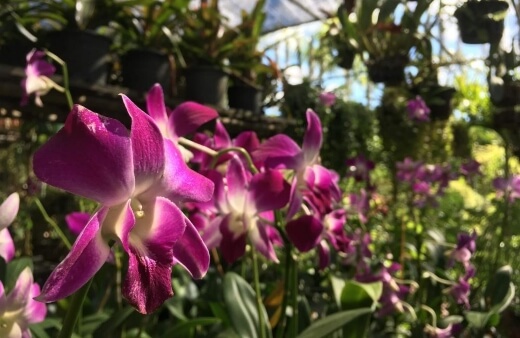
There are over 50 species native to Australia, and they come in every colour under the sun. Grown in part shade, they turn carbon and toxins in city spaces into clean air, with structural foliage, and breath-taking flowers.
(Also see our Cooktown orchids, Dendrobium bigibbum growing guide which is another species of the same genus.)
Buddleia (Buddleja)
As well as being an efficient air purifier, buddleias are brilliant plants for wildlife. No matter how high up your balcony is, these plants will grow in full sun, part shade, wind, salty air, or dry shade.
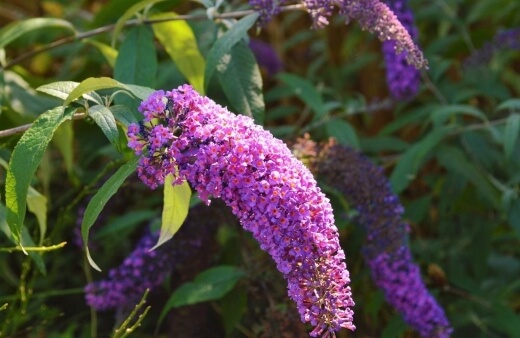
They can be invasive, and spread incredibly easily, especially in wetter climates, but regular deadheading will keep them under control.
There is truly no better plant for attracting wildlife, and transporting you away from busy city balcony life. For more info, check out our ultimate how to grow and care for Buddleia guide.
Here are more air purifying plants to grow in your home.
Shade Loving Balcony Plants
Broad-leaved Palm Lily (Cordyline petiolaris)
By nature, palm lilies are rainforest plants. And against all our better instincts don’t require that much water to thrive, because in their natural habitat, most water is rapidly drunk by surrounding trees, leaving them to adapt to dry shade.
Their palm like-foliage adds an instant tropical impact to your garden, and they’re hardy throughout Australia. I'm certain you will find our growing and planting Cordyline Australian guide quite useful.
Camellia
Camellias are where tea comes from. In full sun, you can harvest and dry the young leaves to make a cup of tea, but in part shade, they grow slowly, providing reliable structure, which is easy to prune and keep to whatever size you need.

They are incredibly frost tolerant, and require very little maintenance. To thank you for a good drink once a month, they will throw out vibrant white, red or pink blooms through summer.
Here is our comprehensive guide on growing Camellia in Australia.
Orange Jasmine (Murraya paniculata)
Orange Jasmine is the perfect balcony plant. They grow in shade, and will appreciate regular watering (but forgive you if you forget), and as another Australian native will easily turn your balcony garden into a green walled oasis with some simple trellis.

And, like all jasmines, their fragrance is their real selling point, filling a balcony of any size with heavenly scent right through summer. Here is everything you'll need to know to grow and care for Murraya paniculata in your home.
Oxygenating Water Plants for Small Ponds
Dwarf Water Lilies
Dwarf Water Lilies are wonderful additions to a balcony pond. Their compact habit makes them controllable, as well as a useful pond plant.
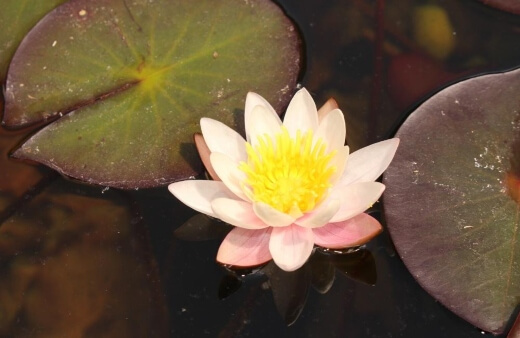
They will keep your water clean and fresh by channelling dirty air into oxygen for the water, and cope with moving water as well as still ponds, so can be added to the base of a water feature as well as a simple barrel pond.
Marsh Marigolds
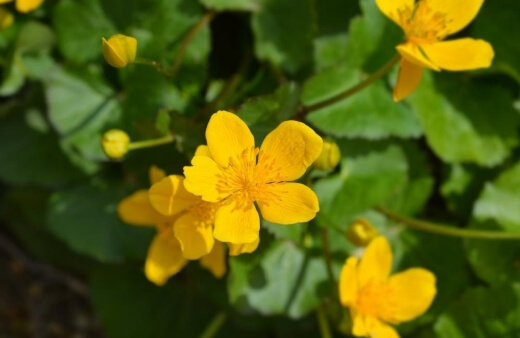
For colour, Marsh Marigolds can’t be beaten as pond plants. Their vibrant yellow flowers attract bees and pollinators to your balcony garden, and as long as they have enough space to spread a few inches every year, they will flower year after year with barely any weight added to your pond.
Should you be interested on growing Marigolds, be sure to check our complete Marigolds how to grow and care guide.
Marsh Forget-Me-Not
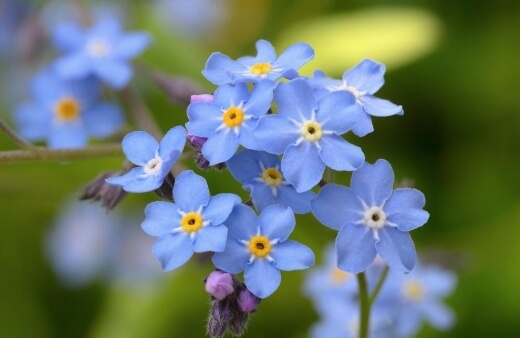
Marsh forget-me-nots are a great alternative to common forget-me-nots for balconies. They spread slowly, and don’t self-seed, unlike their invasive land-based namesake.
Best Trees for Balcony Gardens
Japanese Maple
Japanese maples are, without doubt, the best tree for a balcony garden. They won’t give you fragrant blossom, and they won’t cope with wind, so are best avoided on higher balconies, but for lower balconies, or balconies without a direct wind they are the brightest, most vibrant tree you can buy for your garden.

They grow with limited root space, but will require a decent sized pot, with perlite and peat free compost to grow to maturity.
But the thing that makes them perfect for balconies is that they will grow from old wood, so you can easily prune them every few years to keep to the size you need.
Check out our in-depth guide on growing Japanese maples here.
Chaenomeles
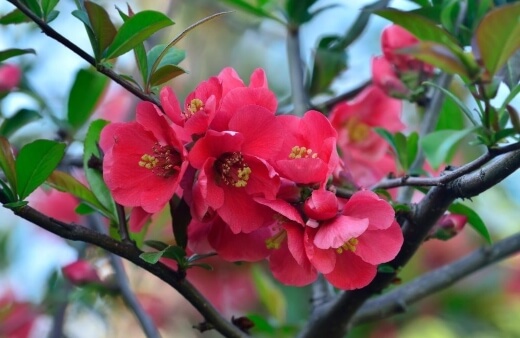
For a productive garden, look no further than Chaenomeles. Their pollinator friendly flowers add unique interest to the balcony garden in spring, with edible fruit in autumn, and like any fruit tree, can be pruned aggressively if it’s getting too big. They prefer light shade too, so are a really versatile plant for any balcony.
Callery Pear Tree
The Callery pear tree (Pyrus calleryana ‘Chanticleer’) is an ornamental pear tree that grows quickly and vertically.
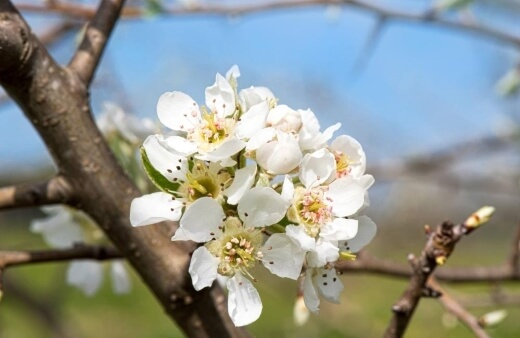
With regular pruning, it can completely bush out a balcony and provide an outstanding, lightweight tree for a balcony garden if you’re worried about weight.
Best Windy Balcony Plants
Viburnum
Viburnum comes in dozens of varieties, but for me, it’s Viburnum tinus that wins when you’re looking for a hardy plant that will cope with windy conditions.
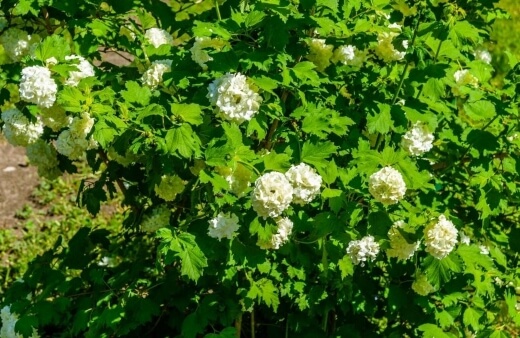
They are incredibly tough plants, and are one of the few ground native shrubs who are perhaps better suited to balconies than their natural habitat.
Their main problem is ants. All ants love all viburnums, so keeping them away from the ground keeps them safe. Their heavily scented spring flowers will get your balcony garden off to a great start every year.
For more info on this beautiful scented flower, check out our Viburnum ultimate growing guide here.
Escallonia
So buxus hedges might be out of the question as a balcony hedge, due to their insatiable thirst, but for a more formal garden, and an effective windbreak, try Escallonia.
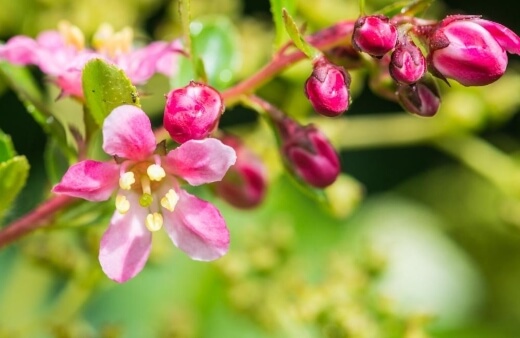
They are fast growing, and need very little care, as well as being well adapted to colder, chiller winds.
Caring for Balcony Plants
A well-planned balcony will care for itself, but there are things you can do to help your balcony garden on its way, mostly by choosing your plants wisely.
Don’t just head straight to Bunnings and buy the first thing that looks good, make sure your plants are going to be happy with higher winds, and always choose plants based on your location.
If you’re South facing, there’s no way you’ll be able to grow Mediterranean vegetables that needs 8 hours a sun per day, but you’ll have a world of choice when it comes to tropical, that like hot shady conditions
Our top tips for caring for balcony plants, no matter what your location are:
- Use self-watering pots to account for lower rainfall
- Plant on trellises to create an enclosed microclimate
- Plant perennial climbers that will clean the air, and block wind
Balcony Plants Frequently Asked Questions
Which plants are best for your balcony?
Herbs make exceptionally useful balcony plants, and if you’re starting a new balcony garden they are a good place to start. Firstly, because they are pretty easy to grow (especially tough Mediterranean herbs like rosemary and thyme, which need little water), and because you’ll begin building your passion for gardening through flavour, which is always a useful starting point!
Can plants survive on a balcony?
No matter what orientation your balcony is, and no matter where it is, there will be plants that can survive and even thrive. South facing balconies in coastal towns, with low light and high salty wind will benefit from tough coastal plants, and even small trees can cope well if kept small in pots and containers.
What can you grow on a shady balcony?
Fuchsias, Begonias, and Ivy are great plants for any shaded balcony, but ferns can provide a forested feel too, with more foliage than most balcony plants through spring, summer, and autumn.
Most shade loving plants for balconies will lose their foliage in winter, but provide a full changing set of seasons, so your balcony might even be a better example of nature than those with warmer, brighter balconies.
How do you beautify a balcony with plants?
If you want to go all out and have some serious impact with your balcony plants, thinking big is the best way to beautify your balcony. Use wall planting systems, railing planters, and grow trees, rather than simple small bedding plants or herbs.
It should be counter intuitive, but bigger plants will make your space seem bigger and more enveloping than a few small pots dotted in the corner.
How can I make a small balcony look nice?
If you’ve got a really small balcony, or even a Juliet balcony, make use of every possible space you have. Use hanging planters for the railings, and grow trailing plants like ivy or jasmine for fragrance.
Design your balcony like a pot; thriller, filler, and spiller. One eye catching plant (trees or shrubs), tons of trailing plants for impact, and easy-to-grow foliage, like ferns to fill the gaps.
Check out our compilation of hanging plants for more options.
What is easy to grow on a balcony?
Balconies provide unique microclimates for keen gardeners and are typically about 2-5% warmer than the surrounding space thanks to escaping heat, and rising heat.
That makes them perfect for year-round salad crops which are easy to grow on any balcony.
What plants will survive winter on a balcony?
Don’t limit yourself by ‘survival rates’ or plants. Choose plants for your balcony that will not only survive winter but thrive. Violas, Hellebores, and Clivia are ideal for winter colour. Even winter flowering shrubs and trees would work well.
Why are my balcony plants dying?
Balcony plants can die for a number of reasons. Mostly it’s down to a lack of water, as high winds can speed up drying and reduce humidity, so they will need more regular water to stay happy and healthy.
Over watering is just as bad though, so avoid watering if the soil is still moist.
What plants are good for pots on balconies?
Mediterranean herbs are ideal for balcony pots all year round, and tend to grow better, and with clearer flavour if they are in their own containers, rather than shared planters.
Grow lavender, rosemary, or sage in pots for year-round interest, and regular harvests.
How often should you water pots on a balcony?
How often you water pots on a balcony depends on the direction of the balcony, and where it is in Australia. North-facing balconies in WA might need watering twice a day in summer, while south-facing balconies might need to be watered once a week even in mid-summer. Make a schedule based on how quickly your soil dries out after watering.
Do balcony planters need drainage holes?
The idea of water spilling out onto your balcony tiles or decking can be off putting, but it is important to add drainage to any balcony planter, container, or pot. Without drainage, water will simply sit in the base of containers, and when the surface is dry, the bottom can be boggy and stagnant which is bad for your plants.
Is it better to water balcony plants in the morning or evening?
The best time of day to water your balcony plants is in the morning. It’s the same with all plants. Watering in the morning allows plants the maximum amount of time to take up the water, and the nutrients it carries.
It’s also the least wasteful time of day in terms of evaporation and reducing excess humidity.

Start Growing These Plants for Balcony Gardens
Balconies make amazing gardens, and provide habitats for plants that no amount of ground level garden ever could. You can create your own tropical paradise, or a pocket of rainforest, but remember that choosing the best plants for balcony gardens depends on your own balcony, and there is no one rule that covers every garden.
Published on January 21, 2023 by Gary Clarke
Last Updated on January 30, 2025




